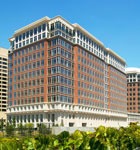Crescent Resources originally was formed as the real-estate-and-timber arm of Duke Energy, and despite a recent rough patch due to the recession, sustainability has long been top a priority for the Charlotte, North Carolina-based company.
“For more than three decades, the guiding philosophy at Crescent Resources has been to create and develop communities that care for the environment and enrich the lives of those who live there,” says Brian Natwick, president of the multifamily division, explaining that each of its multifamily communities is pursuing, or has achieved a level of green certification by a nationally recognized program, including LEED, NAHB Green, and Audubon International.
With the company’s new Circle communities, it is continuing the efforts of serving the environment. The clubhouse at Circle at Concord Mills features energy-saving doors and windows, native landscaping, water-efficient plumbing fixtures, and energy-efficient mechanical systems, among other features. The first LEED-certified structure in Cabarrus County, North Carolina, also offers preferred parking for hybrid and fuel-efficient vehicles.
The company’s interest in sustainability is present across the board, and Elizabeth McMillan, a project manager in the commercial division, reports that all of the office buildings under design and development are registered with the USGBC. “We are also undergoing Energy Star certification for all of our existing buildings that we manage, lease, and own,” she says.
One and Two Potomac Yard is a prime example of the company’s commercial sustainable efforts. Located on a formerly abandoned railroad yard in Arlington, Virginia, the rehab project consists of two 12-story buildings providing 654,000 square feet of office and retail spaces.

Circle Austin at UT: Crescent Resources has an eco-friendly Circle community under construction in Austin, Texas—its first to serve college students.
Completed in May 2006, One and Two Potomac Yard were certified LEED Gold under the New Construction rating, earning 44 and 43 possible points (out of 69), respectively. The efforts that earned them: 27 percent of the building materials contained recycled content; 63 percent of the materials were manufactured within a 500-mile radius; 83 percent of wood-based materials were certified by the FSC; and a 41-percent water-use reduction was achieved through water-saving technologies.
Capping these sustainable successes is the company culture. “It has been great to work for a company that cares about the environment and the community they’re a part of,” McMillan says. “The real key to our success is the dedication to quality and serving the communities in which we develop.”

